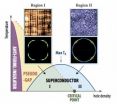(Press-News.org) Ozone pollution across the continental United States will become far more difficult to keep in check as temperatures rise, according to new research results.
The study shows that Americans face the risk of a 70 percent increase in unhealthy summertime ozone levels by 2050.
The results appear online this week in a paper in the Journal of Geophysical Research-Atmospheres, published by the American Geophysical Union.
The work was funded by the National Science Foundation (NSF) and the U.S. Department of Energy.
Warmer temperatures and other changes in the atmosphere related to a changing climate, including higher atmospheric levels of methane, spur chemical reactions that increase overall levels of ozone.
Unlike ozone in the stratosphere, which benefits life on Earth by blocking ultraviolet radiation from the sun, ground-level ozone can trigger a number of health problems.
These range from coughing and throat irritation to more serious aggravation of asthma, bronchitis and emphysema.
Even short periods of unhealthy ozone levels can cause local death rates to rise. Ozone pollution also damages crops and other plants.
Unless emissions of specific pollutants associated with the formation of ozone are sharply cut, most of the continental United States will experience more summer days with unhealthy air by 2050, the research shows.
Heavily polluted locations in parts of the East, Midwest and West Coast, in which ozone already frequently exceeds recommended levels, could face unhealthy summer air in most years.
"It doesn't matter where you are in the United States, climate change has the potential to make your air worse," said National Center for Atmospheric Research (NCAR) scientist Gabriele Pfister, lead scientist on the study.
In addition to NCAR, the paper co-authors are from the Pacific Northwest National Laboratory; University of Colorado, Boulder; and North-West University in South Africa.
"A warming planet doesn't just mean rising temperatures, it also means risking more summertime pollution and the health effects that come with it," said Pfister.
However, the research also showed that a sharp reduction in the emissions of certain pollutants would lead to dramatically decreased levels of ozone even as temperatures warm.
The research is one of the first of its type to be conducted with new, highly advanced geoscience supercomputing capabilities.
"Understanding future changes in surface ozone over the summer has tremendous implications for air quality and human health," said Anjuli Bamzai, a program director in NSF's Division of Atmospheric and Geospace Sciences, which funded the research through NSF's Decadal and Regional Climate Prediction using Earth System Models (EaSM) Program.
"Through a series of 'what if' simulations," said Bamzai, "atmospheric chemists, climate modelers, regional modelers and developers of emissions scenarios demonstrate that a balance of emission controls can counteract the increases in future temperatures, emissions and solar radiation that in turn lead to decreases in surface ozone."
Ozone and heat
Ozone pollution is not emitted directly. It forms as a result of chemical reactions that take place between nitrogen oxides and volatile organic compounds in the presence of sunlight.
These gases come from human activities such as combustion of coal and oil, as well as natural sources such as emissions from plants.
To examine the effects of climate change on ozone pollution, Pfister and colleagues looked at two scenarios.
In one, emissions of nitrogen oxides and volatile organic compounds from human activities would continue at current levels through 2050.
In the other, emissions would be cut by 60-70 percent. Both scenarios assumed continued greenhouse gas emissions with significant warming.
The researchers found that, if emissions continue at present-day rates, the number of eight-hour periods in which ozone would exceed 75 parts per billion (ppb) would jump by 70 percent on average across the United States by 2050.
The 75 ppb level over eight hours is the threshold that is considered unhealthy by the U.S. Environmental Protection Agency. (The agency is considering tightening the standard to a value between 65 and 70 ppb over eight hours.)
Overall, the study found that, 90 percent of the time, ozone levels would range from 30 to 87 ppb in 2050 compared with an estimated 31 to 79 ppb at present.
Although the range itself shifts only slightly, the result is a much larger number of days above the threshold considered unhealthy.
There are three primary reasons for the increase in ozone with climate change:
Chemical reactions in the atmosphere that produce ozone occur more rapidly at higher temperatures.
Plants emit more volatile organic compounds at higher temperatures, which can increase ozone formation if mixed with pollutants from human sources.
Methane, which is increasing in the atmosphere, contributes to increased ozone globally and will enhance baseline levels of surface ozone across the United States.
In the second scenario, Pfister and colleagues found that sharp reductions in nitrogen oxides and volatile organic compounds could reduce ozone pollution even as the climate warms.
In fact, 90 percent of the time, ozone levels would range from 27 to 55 ppb.
The number of instances when ozone pollution would exceed the 75 ppb level dropped to less than 1 percent of current cases.
"Our work confirms that reducing emissions of ozone precursors would have an enormous effect on the air we all breathe," Pfister said.
Pfister and a nationwide scientific team expect to learn more about the sources, chemistry and movement of air pollutants this summer when they launch a major field experiment known as FRAPPÉ along Colorado's Front Range.
The role of supercomputing
The study was among the first conducted on the new 1.5 petaflops Yellowstone supercomputer. The IBM system, operated by NCAR and supported by funding from NSF and the University of Wyoming, is one of the world's most powerful computers dedicated to research in the atmospheric and related sciences.
"High resolution models can consume significant time and resources on massive computers, but as shown in this research, they're often required for accurate regional ozone projections," said Irene Qualters, division director for Advanced Computing Infrastructure at NSF.
"Running these models wouldn't have been possible without the parallel processing power of the Yellowstone supercomputer, a critical part of NSF's cyberinfrastructure.
"The work will also help other researchers in related climate topics determine scenarios where coarse resolution is sufficient and, conversely, where high resolution is needed."
Thanks to its computing power, the scientists were able to simulate pollution levels hour-by-hour for 39 hypothetical summers.
This allowed the team to account for year-to-year variations in meteorological conditions, such as hot and dry vs. cool and wet, thereby getting a more detailed and statistically significant picture of future pollution levels.
To simulate the interplay of global climate with regional pollution conditions, the scientists turned to two of the world's leading atmospheric models, both based at NCAR and developed through collaborations in the atmospheric sciences community.
They used the Community Earth System Model, funded primarily by the U.S. Department of Energy and NSF, to simulate global climate as well as atmospheric chemistry conditions.
They also used an air chemistry version of the multiagency Weather Research and Forecasting Model to obtain a more detailed picture of regional ozone levels.
Even with Yellowstone's advanced computing speed, it took months to complete the complex simulations.
"This research would not have been possible even just a couple of years ago," said Pfister.
"Without the new computing power made possible by Yellowstone, you cannot depict the necessary detail of future changes in air chemistry over small areas, including the urban centers where most Americans live."
INFORMATION:
-NSF-
Climate change may worsen summertime ozone pollution
Americans face 70 percent increase in unhealthy ozone levels by 2050
2014-05-08
ELSE PRESS RELEASES FROM THIS DATE:
Scientists find solution to 2 long-standing mysteries of cuprate superconductivity
2014-05-08
UPTON, NY—Scientists seeking to understand the intricacies of high-temperature superconductivity—the ability of certain materials to carry electrical current with no energy loss—have been particularly puzzled by a mysterious phase that emerges as charge carriers are added that appears to compete with superconductivity. It's also been a mystery why, within this "pseudogap" phase, the movement of superconducting electrons appears to be restricted to certain directions. So exploring the pseudogap and whether and how it affects the movement of electrons has been a pivotal challenge. ...
'Rice theory' explains north-south China cultural differences, study shows
2014-05-08
A new cultural psychology study has found that psychological differences between the people of northern and southern China mirror the differences between community-oriented East Asia and the more individualistic Western world – and the differences seem to have come about because southern China has grown rice for thousands of years, whereas the north has grown wheat.
"It's easy to think of China as a single culture, but we found that China has very distinct northern and southern psychological cultures and that southern China's history of rice farming can explain why people ...
Exploring the magnetism of a single atom
2014-05-08
Magnetic devices like hard drives, magnetic random access memories (MRAMs), molecular magnets, and quantum computers depend on the manipulation of magnetic properties. In an atom, magnetism arises from the spin and orbital momentum of its electrons. 'Magnetic anisotropy' describes how an atom's magnetic properties depend on the orientation of the electrons' orbits relative to the structure of a material. It also provides directionality and stability to magnetization. Publishing in Science, researchers led by EPFL combine various experimental and computational methods to ...
Plant hormone has dual role in triggering flower formation, Penn study finds
2014-05-08
Flowers aren't just pretty to look at, they are how plants reproduce. In agricultural plants, the timing and regulation of flower formation has economic significance, affecting a crop's yield.
A new paper by researchers at the University of Pennsylvania published in the journal Science has revealed that a plant hormone once believed to promote flower formation in annual plants also plays a role in inhibiting flowers from forming. The dual role of this hormone, gibberellin, could be exploited to produce higher-yielding crop plants.
The study was led by Nobutoshi Yamaguchi ...
GaitTrack app makes cellphone a medical monitor for heart and lung patients
2014-05-08
CHAMPAIGN, Ill. — By simply carrying around their cellphones, patients who suffer from chronic disease could soon have an accurate health monitor that warns their doctors when their symptoms worsen.
GaitTrack, an app developed by researchers at the University of Illinois at Urbana-Champaign and the U. of I. at Chicago, turns a smartphone into a sophisticated medical device. Unlike other apps that merely count steps, GaitTrack uses eight motion parameters to perform a detailed analysis of a person's gait, or walking pattern, which can tell physicians much about a patient's ...
Tackling test anxiety may help prevent more severe problems
2014-05-08
Showing students how to cope with test anxiety might also help them to handle their built-up angst and fretfulness about other issues. The results of a new study by Carl Weems of the University of New Orleans show that anxiety intervention programs that focus on academic matters fit well into the demands of the school routine, and do not carry the same stigma among youth as general anxiety programs do. The research group was among the first to study the effects of Hurricane Katrina on community mental health and anxiety among youths, and the paper appears in Prevention ...
Ovarian cancer cells are more aggressive on soft tissues
2014-05-08
When ovarian cancer spreads from the ovaries it almost always does so to a layer of fatty tissue that lines the gut. A new study has found that ovarian cancer cells are more aggressive on these soft tissues due to the mechanical properties of this environment. The finding is contrary to what is seen with other malignant cancer cells that seem to prefer stiffer tissues.
"What we found is that there are some cancer cells that respond to softness as opposed to stiffness," said Michelle Dawson, an assistant professor in the School of Chemical and Biomolecular Engineering ...
Army drug users twice as likely to use synthetic marijuana as regular marijuana
2014-05-08
Social work researchers from the University of Washington have found that among a group of active-duty Army personnel who use illicit drugs, the most abused substance is synthetic marijuana, which is harder to detect than other drugs through standard drug tests.
The research will be published in the July 2014 issue of Addictive Behaviors, but is already online.
Synthetic marijuana, sometimes called "Spice," is made with shredded plant material coated with chemicals that are designed to mimic THC, the psychoactive compound found naturally in marijuana. The U.S. Drug ...
Single cell genome sequencing of malaria parasites
2014-05-08
SAN ANTONIO, May 8, 2014 – A new method for isolating and genome sequencing an individual malaria parasite cell has been developed by Texas Biomed researchers and their colleagues. This advance will allow scientists to improve their ability to identify the multiple types of malaria parasites infecting patients and lead to ways to best design drugs and vaccines to tackle this major global killer. Malaria remains the world's deadliest parasitic disease, killing 655,000 people in 2010.
Malaria parasite infections are complex and often contain multiple different parasite genotypes ...
New genomics technique could improve treatment and control of Malaria
2014-05-08
Single-cell genomics could provide new insight into the biology of Malaria parasites, including their virulence and levels of drug resistance, to ultimately improve treatment and control of the disease, according to new research funded by the Wellcome Trust and the National Institutes of Health.
The findings are revealed in a study by researchers at the Texas Biomedical Research Institute and published today in the journal Genome Research.
Malaria infections commonly contain complex mixtures of Plasmodium parasites which cause the disease. These mixtures, known as multiple ...
LAST 30 PRESS RELEASES:
S-species-stimulated deep reconstruction of ultra-homogeneous CuS nanosheets for efficient HMF electrooxidation
Mechanical and corrosion behavior of additively manufactured NiTi shape memory alloys
New discovery rewrites the rules of antigen presentation
Researchers achieve chain-length control of fatty acid biosynthesis in yeast
Water interactions in molecular sieve catalysis: Framework evolution and reaction modulation
Shark biology breakthrough: Study tracks tiger sharks to Maui mating hub
Mysterious iron ‘bar’ discovered in famous nebula
World-first tool reduces harmful engagement with AI-generated explicit images
Learning about public consensus on climate change does little to boost people’s support for action, study shows
Sylvester Cancer Tip Sheet for January 2026
The Global Ocean Ship-Based Hydrographic Investigations Program (GO-SHIP) receives the Ocean Observing Team Award
Elva Escobar Briones selected for The Oceanography Society Mentoring Award
Why a life-threatening sedative is being prescribed more often for seniors
Findings suggest that certain medications for Type 2 diabetes reduce risk of dementia
UC Riverside scientists win 2025 Buchalter Cosmology Prize
SETI Institute opens call for nominations for the 2026 Tarter Award
Novel theranostic model shows curative potential for gastric and pancreatic tumors
How beige fat keeps blood pressure in check
Fossils reveal ‘latitudinal traps’ that increased extinction risk for marine species
Review: The opportunities and risks of AI in mental health research and care
New map reveals features of Antarctic’s ice-covered landscape
Beige fat promotes healthy vascular function and blood pressure in mice
Chronic low-dose pesticide exposure reduces the life span of wild lake fish, China-based study shows
Tiny earthquakes reveal hidden faults under Northern California
Long-term pesticide exposure accelerates aging and shortens lifespan in fish
Professor Tae-Woo Lee's research group develops groundbreaking perovskite display technology demonstrating the highest efficiency and industry-level operational lifetime
The “broker” family helps tidy up the cell
Ecology: Mummified cheetahs discovery gives hope for species’ Arabic reintroduction
Researchers survey the ADHD coaching boom
Air pollution and cardiac remodeling and function in patients with breast cancer
[Press-News.org] Climate change may worsen summertime ozone pollutionAmericans face 70 percent increase in unhealthy ozone levels by 2050





